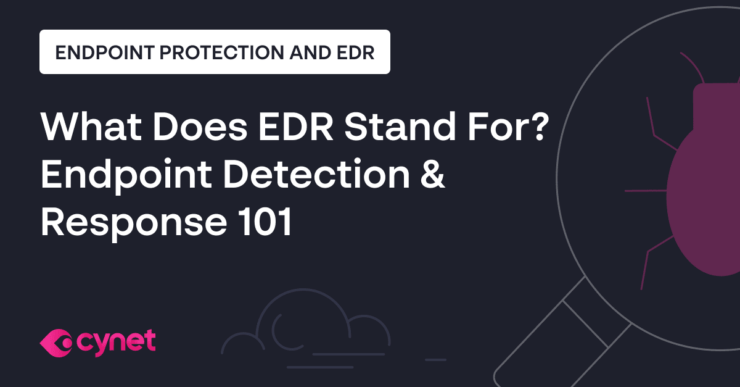April 3, 2023
Last Updated:
January 17, 2025
What Is Endpoint Detection and Response (EDR)?
Endpoint detection and response (EDR) is a cybersecurity technology that provides real-time detection, investigation, and response to security threats on endpoints, such as desktops, laptops, and servers.
EDR solutions work by collecting data from endpoints, including system logs, network traffic, and other types of telemetry. This data is then analyzed in real-time using advanced analytics and machine learning techniques to identify potential threats. Once a threat is identified, EDR solutions can respond to the threat in a number of ways, including isolating the endpoint, quarantining the file, blocking network communication, and more.
EDR solutions are designed to complement traditional antivirus and firewalls by providing additional layers of protection and detection capabilities. They can help organizations identify and respond to threats that may have been missed by other security solutions. EDR solutions are especially useful in identifying and responding to advanced threats, such as fileless malware, zero-day attacks, and other sophisticated attack techniques.
Key Security Problems the Healthcare Industry Is Facing
The healthcare industry faces several security problems, including:
Data breaches
Healthcare organizations store vast amounts of sensitive patient data, such as medical records, financial information, and personal identifiers. Data breaches can occur due to various reasons, such as insider threats, external attacks, or human error.
Ransomware attacks
Ransomware is a type of malicious software that encrypts data on a victim’s computer and demands a ransom payment in exchange for the decryption key. Healthcare organizations are particularly vulnerable to these attacks because of the sensitive nature of the data they hold.
Medical device vulnerabilities
Medical devices such as pacemakers, insulin pumps, and other implantable devices are vulnerable to cyber-attacks. These attacks can lead to severe consequences such as changing the settings of the devices or causing them to malfunction.
Insider threats
Insider threats refer to the risk of employees or other authorized personnel intentionally or unintentionally disclosing sensitive information. This can occur due to a lack of security awareness, poorly enforced security policies, or even malicious intent.
Third-party risks
Healthcare organizations work with several third-party vendors, such as billing companies and technology providers, which can lead to security risks. These vendors may not have the same level of security measures in place as the healthcare organization, making it easier for attackers to target them.
3 Ways EDR Can Improve Healthcare Security
Ransomware Protection
Ransomware is a type of malware that infects computers and encrypts files, making them inaccessible until a ransom is paid. Healthcare organizations are a prime target for ransomware attacks due to the sensitive patient data they store. Ransomware attacks can cause significant disruption to patient care and can even put patients’ lives at risk.
Here’s how EDR solutions can help protect healthcare organizations against ransomware attacks:
- Monitoring endpoints: EDR solutions can monitor endpoints in the healthcare organization’s network for suspicious activity that could be indicative of a ransomware attack. This could include changes to system files, encryption of files, and network communication with known ransomware domains.
- Detecting ransomware: EDR solutions can identify ransomware attacks through machine learning and other advanced techniques. Once EDR solutions detect when an endpoint has been infected with ransomware, the solution alerts security personnel.
- Isolating infected endpoints: EDR solutions can isolate the infected endpoint and quarantine infected files or block network communication with known ransomware domains. This can help prevent the malware from spreading to other parts of the network.
- Automated rollback: EDR solutions can automatically roll back changes made by the ransomware, restoring the endpoint to its previous state. This can help minimize the damage caused by the attack and reduce the amount of time required to recover.
Learn more in our detailed guide to edr stands for.
Managing Medical Device Risks
Medical devices such as pacemakers, insulin pumps, and other implantable devices are vulnerable to cyber attacks. These devices are used to monitor vital signs, deliver medications, and control other aspects of patient care. An attacker who gains access to these devices can cause serious harm to patients.
Here’s how EDR solutions can help healthcare organizations manage medical device risks:
- Monitoring device configurations: EDR solutions can monitor the configuration of medical devices, such as firmware versions and network connections, to ensure they comply with the organization’s security policies. Once a device is connected to an unauthorized network or there is unauthorized access to the device, the solution flags it as suspicious activity.
- Identifying potential vulnerabilities: EDR solutions can identify potential vulnerabilities in medical devices by monitoring network traffic and analyzing system logs. This can help healthcare organizations take proactive measures to address any security issues before they are exploited by attackers.
- Detecting unauthorized changes: EDR solutions can detect when unauthorized changes are made to medical devices, such as changes to settings or configurations. This can help prevent malicious actors from exploiting vulnerabilities in the device.
EDR solutions alert security personnel when a potential threat is detected to ensure security personnel can take quick action to address the issue and prevent any further damage.
- Tailor EDR configurations for HIPAA compliance
Beyond standard compliance features, ensure that your EDR solution is customized for HIPAA requirements by enforcing granular access controls and continuous monitoring of PHI (Protected Health Information) endpoints. This reduces the risk of non-compliant access or data leakage.
- Employ predictive analytics for insider threat detection
Leverage EDR’s advanced analytics to detect subtle behavioral shifts that indicate insider threats, such as employees accessing unusual patient records or attempting unauthorized transfers of data. Early detection helps avoid major breaches.
- Implement behavioral baselining for anomaly detection
Healthcare systems often experience predictable traffic patterns. Use EDR to baseline normal endpoint behavior and detect anomalies, such as unusual file access times or sudden data spikes from medical devices, which may signal ongoing attacks.
- Prepare automated playbooks for rapid response
Develop automated response playbooks within your EDR for common healthcare-specific incidents, such as ransomware attacks or unauthorized medical device access. Automation ensures that response is swift, minimizing potential damage.
- Leverage forensic capabilities for incident investigations
EDR’s ability to provide detailed forensic data is crucial in healthcare breaches. Use this feature to trace the origin and scope of an attack, allowing quicker root-cause analysis and enabling compliance teams to produce detailed incident reports.
Eyal Gruner is the Co-Founder and Board Director at Cynet. He served as the company’s CEO for nine years, guiding its growth from the very beginning. He is also Co-Founder and former CEO of BugSec, Israel’s leading cyber consultancy, and Versafe, acquired by F5 Networks. Gruner began his career at age 15 by hacking into his bank’s ATM to show the weakness of their security and has been recognized in Google’s security Hall of Fame.
Managing Healthcare Data Compliance
Healthcare organizations are required to comply with various regulations, such as the Health Insurance Portability and Accountability Act (HIPAA), to protect patient data. Non-compliance can lead to hefty fines and penalties, as well as reputational damage.
Here’s how EDR solutions can help healthcare organizations manage healthcare data compliance:
- Enforcing security policies: EDR solutions can enforce security policies, such as access controls and encryption, to ensure that patient data is protected. This can help healthcare organizations comply with regulatory requirements.
- Maintaining audit trails: EDR solutions can maintain audit trails of security incidents, such as data breaches and malware infections. This can help healthcare organizations demonstrate compliance with regulatory requirements and provide evidence.
- Compliance reporting: EDR solutions can generate detailed reports on security incidents and compliance status. These reports can be used to demonstrate compliance with regulatory requirements to auditors and regulatory bodies.


![Top 6 EDR Tools Compared [2025 Update] image](https://www.cynet.com/wp-content/uploads/fly-images/46568/ENDPOINT-PROTECTION-and-EDR_1200x6277-740x424.png)
